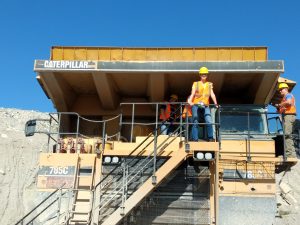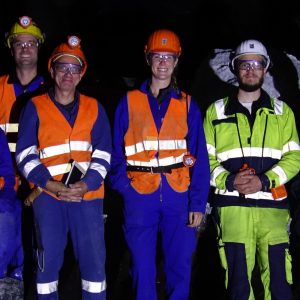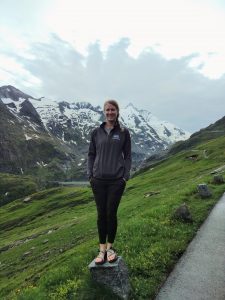Elizabeth Graybill Lantzsch – 2010

Liz on a 100 Ton quarry haul truck
When I arrived at Lafayette as an International Business major, I wanted to get my science requirements completed as quickly and painlessly as possible. I heard through some friends on the basketball team that “Rocks for Jocks,” AKA intro geology classes were the way to go. I signed up for Kira Lawrence’s climate course. I learned very quickly that it was not the “easy way out” for sciences, but I also realized that it was fascinating and I had no problem putting the work in. I decided to take another class, Dave Sunderlin’s “Dinosaurs, Darwin, and Deep Time.” This truly sealed the deal for me, and I was hooked.
I was a member of the track and field team for all four years at Lafayette. I am thankful for my pursuit in athletics because if not for track, I never would have attended Lafayette. The most important skills that being a student athlete and science major taught me was time management and accountability. In addition to lab courses, I had 2+ hours of practice every day, and meets on many weekends. My senior year was one of the most challenging, as I was juggling upper level courses and the peak of my track career. The geology professors were always very good about working with athletes (Kira Lawrence was a D1 basketball player!), and I graduated as a well-disciplined student athlete. When I got to grad school, I can honestly say that my first year was easier than Lafayette, and I had more time than I knew what to do with! I came to Lafayette as a jock, but I left as a nerd!

Liz visiting an underground magnesite mine in Breitenau, Austria
The best thing that happened to me at Lafayette was getting a summer internship at the PA State Geologic Survey. This is where I met my first professional geology mentor, who turned out to be critical in my career path. Dr. Ganis was studying graptolite biostratigraphy for a state mapping project, and I was able to spend some time in the field with him. I learned that his primary job was independent geologic consulting to the mining industry. After I proved myself as a young geologist, and he asked me to help him with his consulting work, Not only did he help me find my passion for the mining industry, Dr. Ganis helped me change my master’s thesis project to mining geology, convinced the mining company to support my MS research, and introduced me to both companies for which I have worked (Kaufman Engineering 2012-2013, RHI Magnesita 2013-present). His mentorship paved the way for a successful career in mining, and it all started with listening to him talk about graptolites ad nauseam.
After Lafayette, I decided to continue to on to grad school for my MS in Geology. I attended Ohio University with the intent on doing a master’s thesis in paleontology. Long story short, after I graduated from Lafayette, I spent my summer working as a mining consultant on a project for a cement quarry. That summer I found my passion for the mining industry, and when I reported to Ohio U. for my grad work in paleontology, I was miserable. At the end of my first year at OU, I decided to change my thesis topic to focus on the quarry from my summer job. From that point on, I have never looked back from the mining industry!

Standing with the tallest peak of the Austrian Alps
I currently work for a global refractories company, RHI Magnesita. Refractories are materials that are resistant to extreme heat, and the materials we produce are used for the steel and cement industries. My job is based in York, PA, where I oversee extraction of high purity dolomite from an open pit quarry. I also have the opportunity to travel all over the world and work with international colleagues as a member of my company’s global raw material support group.
The mining industry is a relatively small sector of employment for geologists, so it can be difficult to get in the door. My advice to students would be to focus on core geology courses and even consider branching out into the engineering department. John Wilson’s GIS class taught me skills that I still use on a weekly basis. Try to learn CAD if you can! Join SME (Society for Mining, Metallurgy, and Exploration), it is a very industry oriented professional society with local chapters in NY, NEPA, Pittsburgh, and D.C. This is a great place to meet mentors or prospective employers! The mining industry is not for the faint of heart. Be prepared to travel to (or live in) remote areas, work with everyone from executives to equipment operators, and to be able to communicate the importance of geology to non-geologists.

Standing inside a tunnel kiln in Chizhou, China
If you are considering a geology career in private industry, consider taking the exam to become a licensed Professional Geologist. Similar to the professional engineering license, it is a two part exam. The first part, Fundamentals of Geology (FG), can be taken once you have 30 credit hours of college level geology. The second part of the exam, Principles and Practice of Geology (PG), can be taken when you have 5 years of experience in the workforce. My advice is to take the FG exam as close to graduation as possible! There are three reasons for this: 1. The information is fresh in your head, take advantage of this! It only gets harder as you spend more time away from school. 2. The exams take multiple hours to complete. Taking two exams in one day makes for a very long and miserable day. Take advantage of being able to split up the two tests. 3. Most importantly, having “G.I.T.” on your resume looks really, really good to prospective employers!
Helpful Links:
PA DCNR Internships: https://www.dcnr.pa.gov/Internships/Pages/default.aspx
Society for Mining, Metallurgy, and Exploration: https://www.smenet.org/
PG Exam Guidance: https://www.asbog.org/
PA PG Application Info: https://www.dos.pa.gov/ProfessionalLicensing/BoardsCommissions/EngineersLandSurveyorsandGeologists/Pages/Initial-Geologist-Application%20Information.aspx
Pitt has a nice roadmap to the PG Exam: https://www.geology.pitt.edu/geology-bs/professional-geologist-license
A great website to look for mining Jobs: http://www.infomine.com/careers/